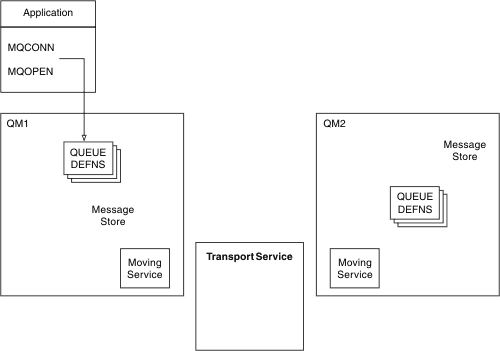How does distributed queuing work?
Figure 1 shows an overview of the components of distributed queuing.
Figure 1. Overview of the components of distributed queuing
- An application uses the MQCONN call to connect to a queue manager.
- The application then uses the MQOPEN call to open a queue so that it can put messages on it.
- A queue manager has a definition for each of its queues, specifying information such as the maximum number of messages allowed on the queue.
- If the messages are destined for a queue on a remote system, the local queue manager holds them in a message store until it is ready to forward them to the remote queue manager. This can be transparent to the application.
- Each queue manager contains communications software called the moving service component; through this, the queue manager can communicate with other queue managers.
- The transport service is independent of the queue manager and can be any one of the following (depending on the platform):
- Systems Network Architecture Advanced Program-to Program Communication (SNA APPC)
- Transmission Control Protocol/Internet Protocol (TCP/IP)
- Network Basic Input/Output System (NetBIOS)
- Sequenced Packet Exchange (SPX)
- What do we call the components?
- Components needed to send a message
- Components needed to return a message
- Cluster components
Parent topic:
What is intercommunication?
ic10250_
Home
